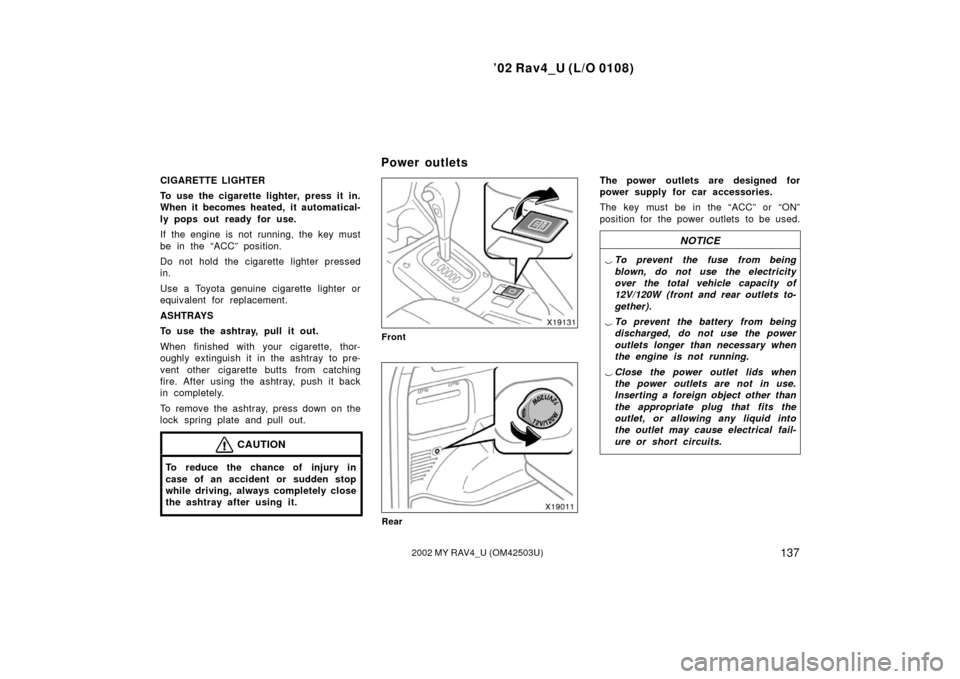Page 146 of 283

’02 Rav4_U (L/O 0108)
1372002 MY RAV4_U (OM42503U)
CIGARETTE LIGHTER
To use the cigarette lighter, press it in.
When it becomes heated, it automatical-
ly pops out ready for use.
If the engine is not running, the key must
be in the “ACC” position.
Do not hold the cigarette lighter pressed
in.
Use a Toyota genuine cigarette lighter or
equivalent for replacement.
ASHTRAYS
To use the ashtray, pull it out.
When finished with your cigarette, thor-
oughly extinguish it in the ashtray to pre-
vent other cigarette butts from catching
fire. After using the ashtray, push it back
in completely.
To remove the ashtray, press down on the
lock spring plate and pull out.
CAUTION
To reduce the chance of injury in
case of an accident or sudden stop
while driving, always completely close
the ashtray after using it.
Front
Rear
The power outlets are designed for
power supply for car accessories.
The key must be in the “ACC” or “ON”
position for the power outlets to be used.
NOTICE
�To prevent the fuse from being
blown, do not use the electricity
over the total vehicle capacity of
12V/120W (front and rear outlets to-
gether).
� To prevent the battery from being
discharged, do not use the power
outlets longer than necessary when
the engine is not running.
� Close the power outlet lids when
the power outlets are not in use.
Inserting a foreign object other than
the appropriate plug that fits the
outlet, or allowing any liquid into
the outlet may cause electrical fail-
ure or short circuits.
Power outlets
Page 182 of 283

’02 Rav4_U (L/O 0108)
1732002 MY RAV4_U (OM42503U)
�In a rollover crash, an unbelted per-
son is significantly more likely to
die than a person wearing a seat
belt. Therefore, the driver and all
passengers should fasten their seat
belts whenever the vehicle is mo-
ving.
�When driving off�road or in rugged
terrain, do not drive at excessive
speeds, jump, make sharp turns,
strike objects, etc. This may cause
loss of control or vehicle rollover
causing death or serious injury. You
are also risking expensive damage
to your vehicle’s suspension and
chassis.
NOTICE
�If driving through water, such as
when crossing shallow streams,
first check the depth of the water
and the bottom of the river bed for
firmness. Drive slowly and avoid
deep water.
�Take all necessary safety measures
to ensure that water damage to the
engine or other components does
not occur.
Water entering the engine air intake
will cause severe engine damage.
Water can wash the grease from
wheel bearings, causing rusting and
premature failure, and may also en-
ter the differentials, transmission
and transfer case, reducing the gear
oil’s lubricating qualities.
� Sand and mud that has accumulated
in brake drums and around brake
discs may affect braking efficiency
and may damage brake system com-
ponents.
� Always perform a maintenance in-
spection after each day of off�road
driving that has taken you through
rough terrain, sand, mud, or water.
For scheduled maintenance informa-
tion, refer to the “Scheduled Main-
tenance Guide” or “Owner’s Manual
Supplement”.Make sure you have a proper freeze
protection of engine coolant.
Your coolant must contain ethylene�glycol
type coolant for a proper corrosion
protection of aluminum components. Use
“TOYOTA Long Life Coolant” or equivalent.
See page 227 in Section 7�2 for details
about coolant type selection.
NOTICE
Do not use alcohol type antifreeze or
plain water alone.
When it is extremely cold, we recommend
to use 60% solution for your Toyota, to
provide protection down to about �50 �C
(�58 �F). Do not use more than 70% solu-
tion for better coolant performance.
Check the condition of the battery and
cables.
Cold temperatures reduce the capacity of
any battery, so it must be in top shape
to provide enough power for winter start-
ing. Section 7�3 tells you how to visually
inspect the battery. Your Toyota dealer
and most service stations will be pleased
to check the level of charge.
Winter driving tips
Page 265 of 283

’02 Rav4_U (L/O 0108)
2562002 MY RAV4_U (OM42503U)
BATTERY
Open voltage
∗ at 20 �C (68 �F):
12.6—12.8 V Fully charged
12.2—12.4 V Half charged
11.8—12.0 V Discharged
∗: Voltage that is checked 20 minutes af-
ter the key is removed with all the lights
turned off
Charging rates: 5 A max.
CLUTCH
Pedal free play, mm (in.): 5—15 (0.2—0.6)
Fluid type: SAE J1703 or FMVSS No.116 DOT 3
MANUAL TRANSAXLE
Oil capacity, L (qt., Imp. qt.): Two�wheel drive models2.5 (2.6, 2.2)
Four�wheel drive models
3.4 (3.6, 3.0)
Oil type: Gear oil API GL�4 or GL�5
Recommended oil viscosity: SAE 75W�90 AUTOMATIC TRANSAXLE
Fluid capacity (drain and ref
ill), L (qt.,
Imp. qt.):
Two�wheel drive modelsUp to 3.3 (3.5, 2.9)
Four�wheel drive models Up to 3.9 (4.1, 3.4)
Fluid type: Automatic transmission fluid Type T�IV
Change automatic transmission fluid only
as necessary.
Generally, it is necessary to change
automatic transmission fluid only if your
vehicle is driven under one of the Special
Operating Conditions listed in your
“Scheduled Maintenance Guide” or
“Owner ’s Manual Supplement”. When
changing the automatic transmission fluid,
use only Toyota Genuine ATF Type T�IV
(ATF JWS3309 or NWS6500) to aid in
assuring optimum transaxle performance.
Notice: Using automatic transmission
fluid other than Toyota Genuine ATF
Type T�IV may cause deterioration in
shift quality, locking up of your trans-
mission accompanied by vibration, and
ultimately damage the automatic trans-
mission of your vehicle. TRANSFER
(four�wheel drive models)
Oil capacity, L (qt., Imp. qt.):
0.9 (1.0, 0.8)
Oil type: Hypoid gear oil API GL�5
Recommended oil viscosity: Above �18 �C (0 �F)
SAE 90 or 85W�90
Below �18 �C (0 �F)
SAE 80W or 80W�90
REAR DIFFERENTIAL
(four�wheel drive models)
Oil capacity, L (qt., Imp. qt.): 0.9 (1.0, 0.8)
Oil type: Hypoid gear oil API GL�5
Recommended oil viscosity: Above �18 �C (0 �F)
SAE 90
Below �18 �C (0 �F)
SAE 80W or 80W�90